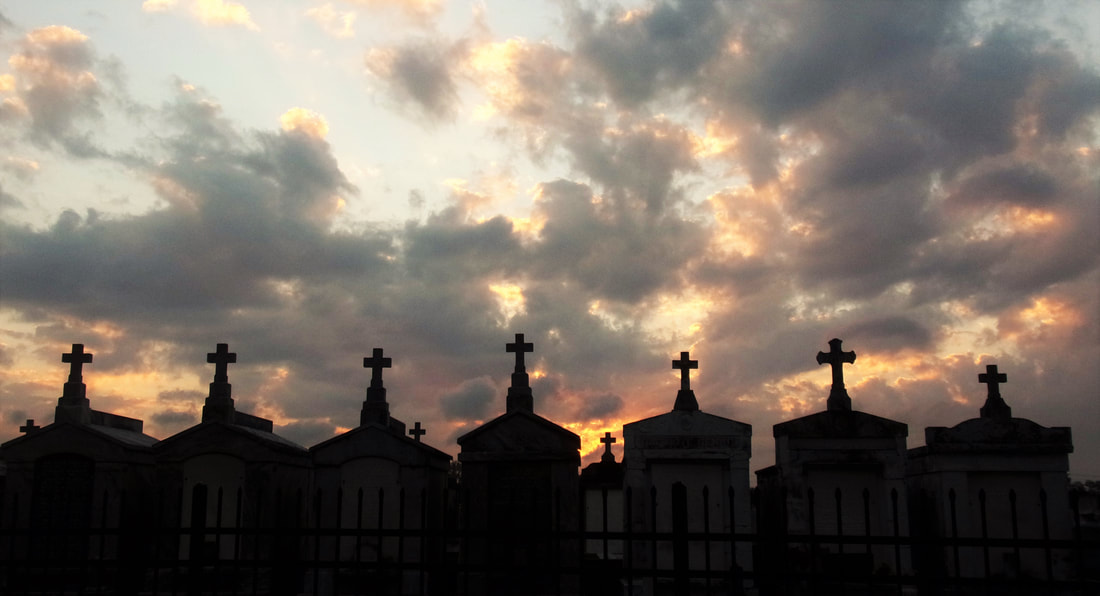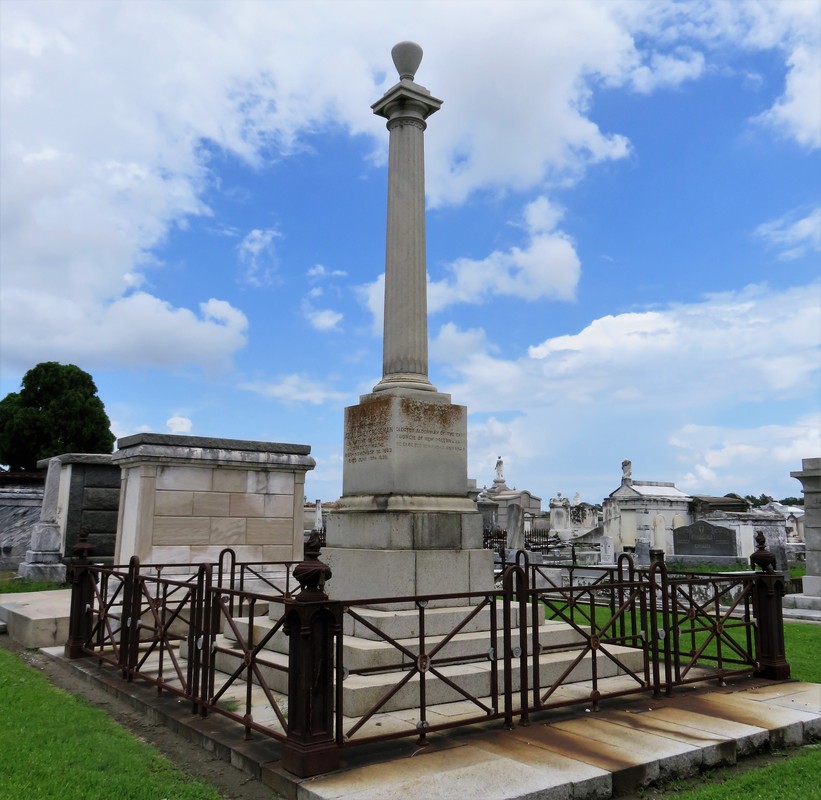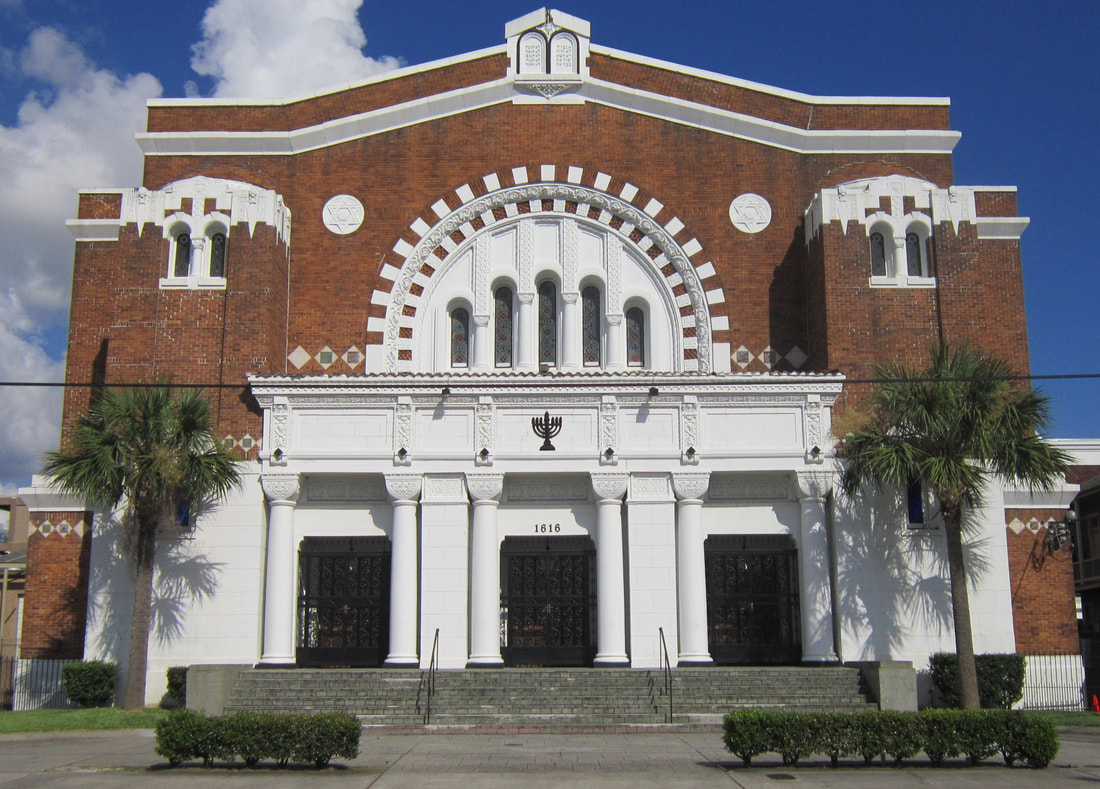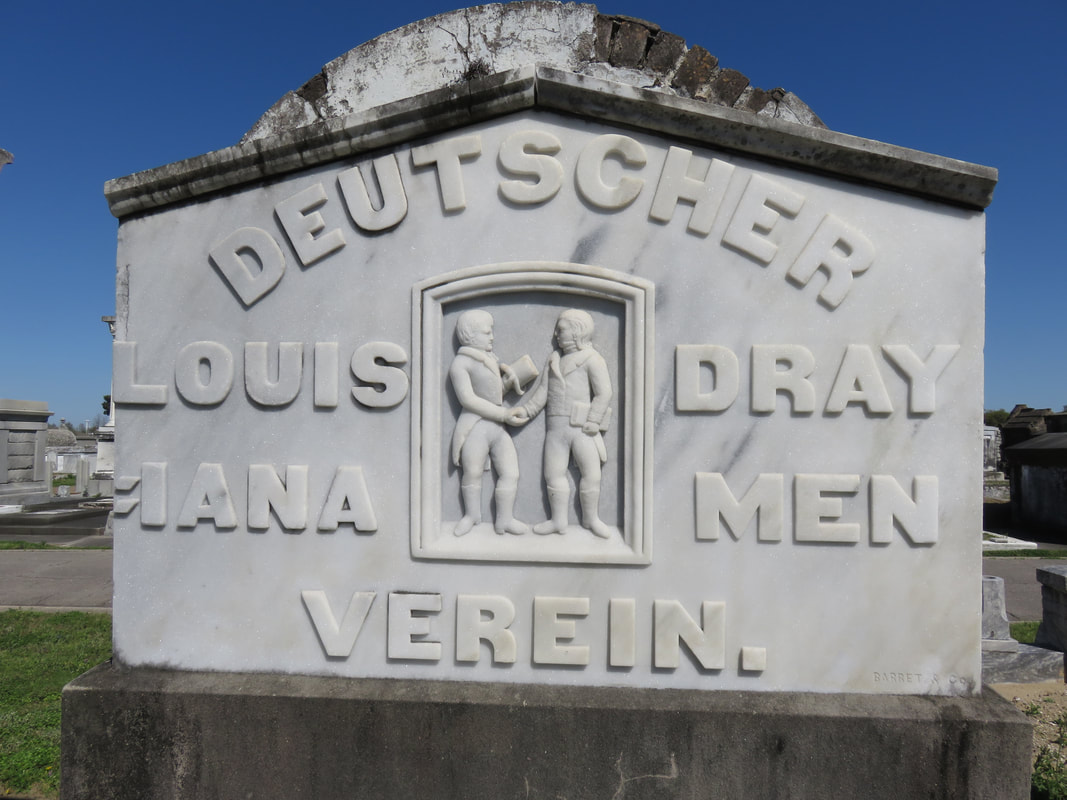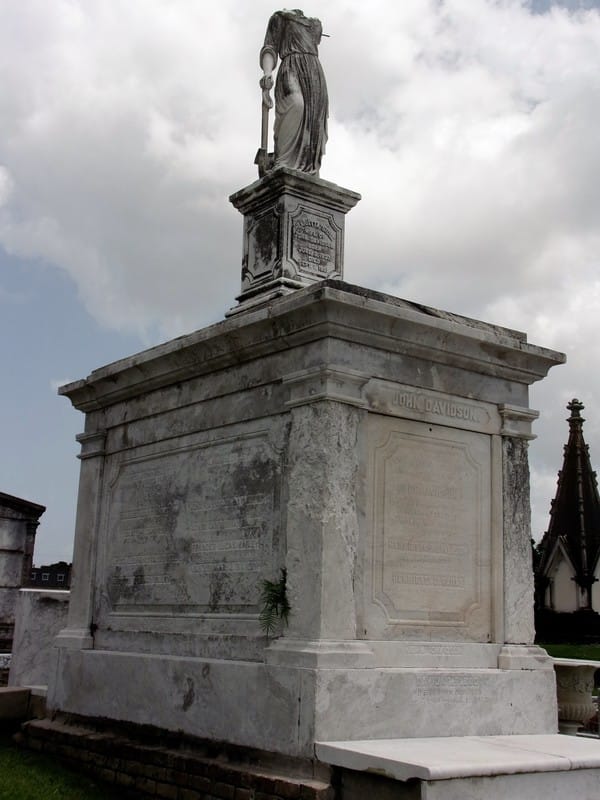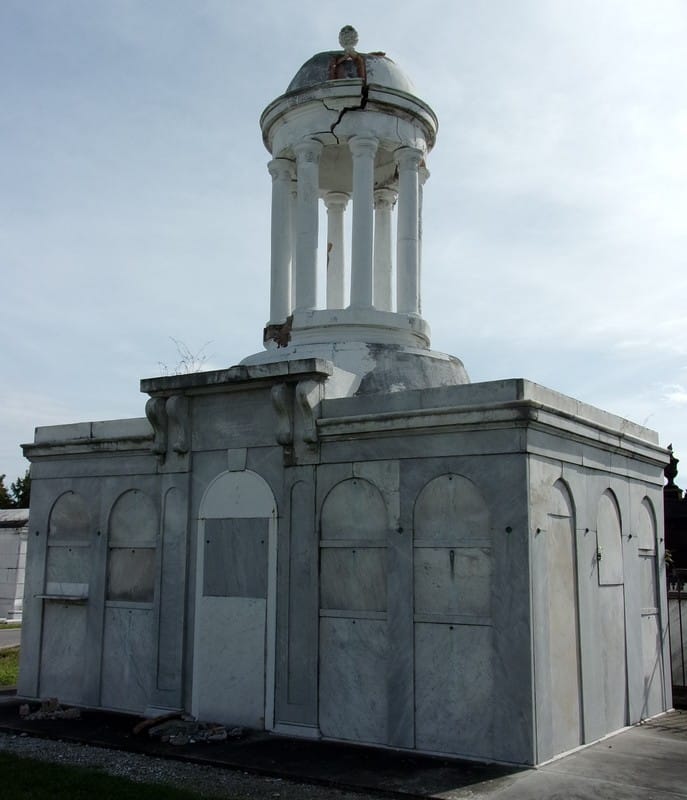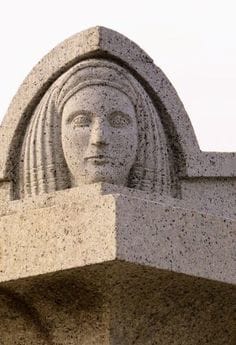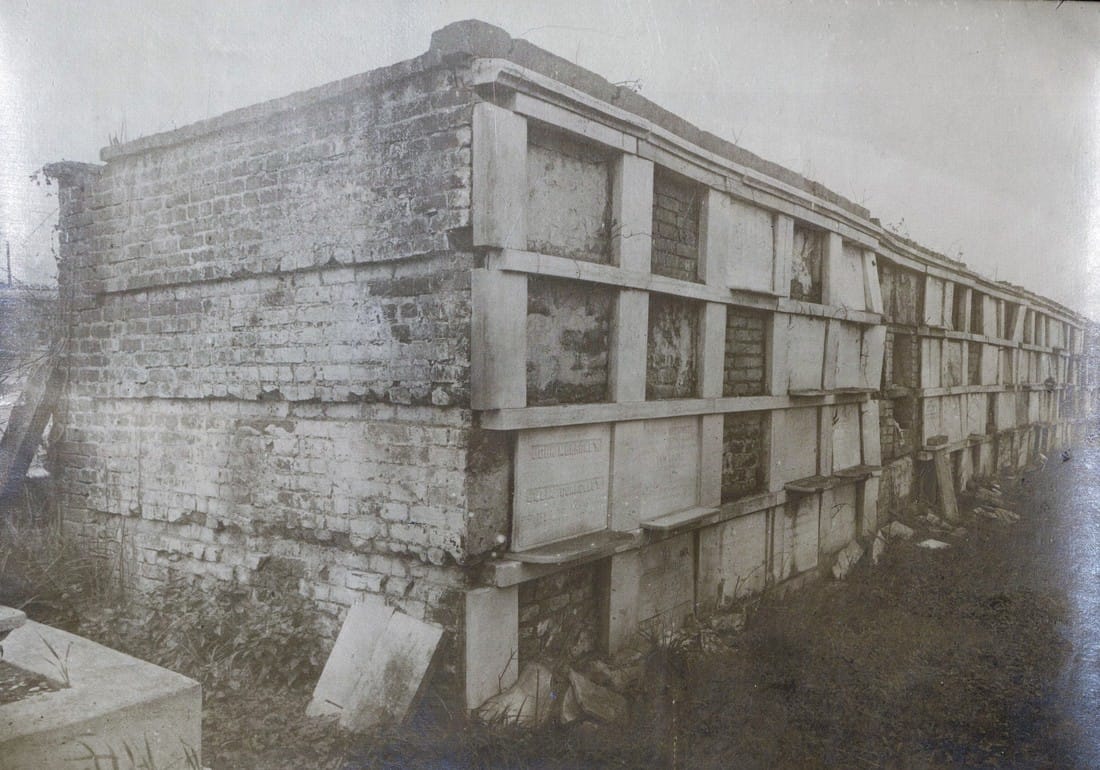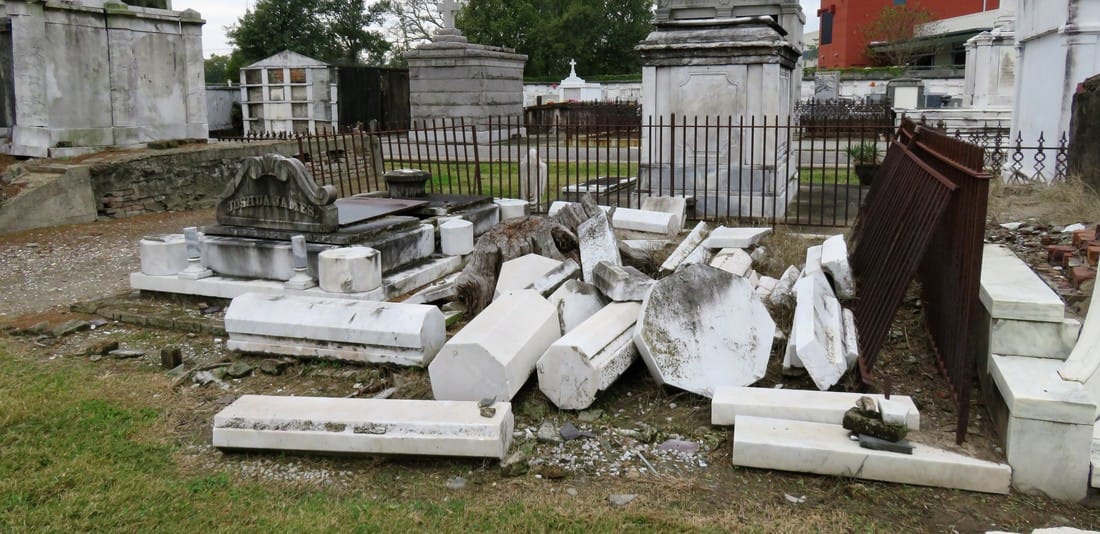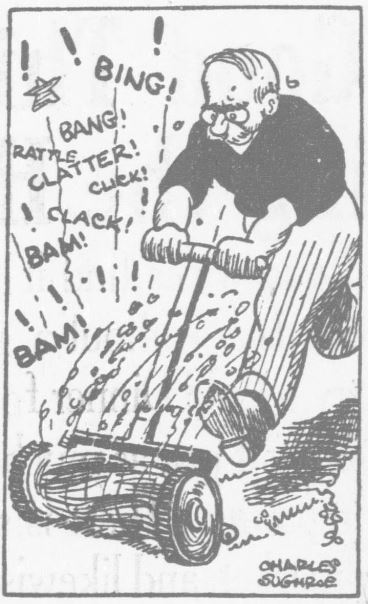|
This is Part Three in a multi-part blog series examining the landscape history of what is now the intersection of Canal Street and City Park Avenue. From July to November 2017, construction will take place at this intersection to connect the Canal Streetcar to Canal Boulevard. Find Part One here and Part Two here. 1852: Greenwood Cemetery By 1850 the terminus of Canal Street remained mostly undeveloped. On each side of Canal approaching Bayou Metairie were the predominantly belowground Dispersed of Judah, St. Patrick’s, and Charity Hospital Cemeteries, each likely bounded by wooden fences. Improvements like the Halfway House, the Toll House, and the walls of Odd Fellows Rest modestly framed the monumental entryway to Cypress Grove Cemetery. Cypress Grove itself was more than a decade old and flourishing as a garden cemetery full of trees and landscape features – despite a fire in 1848 that destroyed many plantings.[1] The Firemen’s Charitable Association had been quite successful in developing Cypress Grove, so much so that demand for lots overran supply. In 1852, the FCA opened Greenwood Cemetery across Bayou Metairie from both Odd Fellows and Cypress Grove. Its eastern boundary would adjoin Cypress Grove Cemetery No. 2, also known as Charity Hospital No. 2. In some ways, Greenwood Cemetery would be a continuation of Cypress Grove – dedicated to the memorial of fallen firemen and stylistically influenced by Anglo-Protestant aesthetics over those of Creole New Orleaneans. In fact, it’s likely no accident that Greenwood Cemetery shared its name with a famous garden cemetery in New York, founded in 1838. However, Greenwood would not accommodate the landscape features and lofty architecture so well fostered by Cypress Grove. Instead, the new Firemen’s cemetery would be organized in compact, neat rows that mirrored the kind of order seen in contemporary cemeteries like St. Louis Cemetery No. 3 on Esplanade Avenue (est. 1854). A grand dedication ceremony like those seen at Cypress Grove and Odd Fellows Rest would not be held for Greenwood Cemetery. This may have been the result of an almost immediate cholera and yellow fever epidemic following the cemetery’s opening. The 1853 yellow fever epidemic would kill as many as 12,000 people in New Orleans, quickly making Greenwood a vital burial ground. Unlike Cypress Grove or Odd Fellows Rest, Greenwood Cemetery was not enclosed with a masonry wall, but an iron fence. This left the southern boundary of the cemetery visually open to the bayou that meandered in front of it. The grassy space left room for display of more impressive monuments. Decades would pass, however, before the most iconic monuments of Greenwood would appear. The Confederate monument (1873), Firemen’s monument (1887), and Elk’s Lodge tumulus (1911) did not yet rise above the bayou. Instead, one of the first monuments to be erected in Greenwood Cemetery would be that of two martyred firefighters. On March 16, 1854, Daniel Woodruff and William McLeod responded to a fire on Magazine Street as members of Mississippi Fire Company No. 2. In the blaze, a wall fell upon Daniel Woodruff and he was killed in action. Later, William McLeod died of injuries sustained in the fire.[2] Exactly one year after the tragic fire, the FCA laid the cornerstone of the fallen men’s memorial tomb. The Firemen traveled to Greenwood Cemetery in a procession to Metairie Ridge where the cornerstone was laid. In Masonic tradition, the architect of the tomb, Sheppard Reynolds, presented the Grand Master of the FCA with a plumb, square, and level with which to test the cornerstone. After it was pronounced level and plumb, the stone was anointed using vessels of corn, wine, and oil. After an oratory, the procession retreated.[3] The Woodruff-McLeod tomb, similar in style but not size to the Teutonia Lodge tomb, was completed by stonecutter and tomb builder Newton Richards (1805 – 1874), who also constructed the Irad Ferry monument. Each arched loggia-like vault memorializes the life and service of Woodruff and McLeod. Yet only one of the two martyrs are actually buried in this tomb. When the time came to re-inter William McLeod in Greenwood his widow objected. His body remained at Girod Street Cemetery. It is unclear where McLeod may have been re-interred after the demolition of Girod Street Cemetery in 1957.[4] Newton Richards had by 1859 constructed the Irad Ferry monument, the Woodruff-McLeod monument, dozens of other tombs in New Orleans cemeteries, and even the granite pedestal atop which the Andrew Jackson statue is mounted in Jackson Square.[5] A man from New Hampshire who specialized in granite monuments, Richards was especially active in the Anglo-Northern associated cemeteries. In 1859, he would once again shape the budding landscape of Greenwood Cemetery by erecting the memorial of former New Orleans mayor Abidel Daily Crossman in Greenwood Cemetery. A.D. Crossman served four consecutive terms as mayor of New Orleans, weathering the city through natural disasters like Sauve’s Crevasse and the 1853 yellow fever epidemic. He oversaw the re-joining of the city from three separate municipalities into one united city government, and local military response to the Mexican-American War. Crossman was from Massachusetts and had long been a friend of the city’s firefighters – serving as a firefighter himself under Eagle Company No. 7.[6] For Crossman, Richards erected a classical Doric column carved of granite and surmounted with an urn. The granite die and stacked bases atop which the column sits are enclosed with cast iron fencing, the corners of which are each topped with cast iron flaming lamps. The cemeteries at the end of Canal Street were tied not only by geography but, in some cases, mutual origins and culture, specifically that of Northern-born Americans. For this reason, it is no surprise that stonecutters and tomb builders with similar backgrounds tended to concentrate their work in Cypress Grove, Greenwood, and Odd Fellows. In fact, the first sexton of Greenwood Cemetery, Daniel Merritt, also served as sexton in Odd Fellows Rest. Carved tablets signed by Merritt are found in all three cemeteries.[7] Greenwood Cemetery greeted a peculiar new tomb construction in the 1860s – tombs built of brick and mortar but clad in cast-iron panels. This style was not exclusive to Greenwood (Lafayette Cemetery No. 1 had the Karstendiek tomb by 1866, and Cypress Grove famously houses the Leeds cast-iron tomb), but Greenwood gathered the highest concentration of these unique structures. Four of these tombs (Marks, Enberger, Summers, and Hetion) were identical catalog-order tombs from the ironwork firm of Wood, Miltenberger, and Company, which had a branch in New Orleans. The Edwards tomb, also of cast iron, was a custom construction erected in 1861 across the aisle from the Woodruff and McLeod tomb. 1858: Tememe Derech Cemetery Jewish immigration to New Orleans continued through the first half of the nineteenth century. Some Jews emigrated from France, Germany, and the contested territory of Alsace-Lorraine between the two countries. By the 1850s, however, other Jewish people from Eastern Europe began to arrive, fleeing pogroms in their home countries. In 1858, Polish Jews formed the Orthodox congregation of Tememe Derech (“The Right Way”). This congregation was the first Eastern European Jewish congregation to construct a purpose-built synagogue, once on Carondelet Street. Tememe Derech also established its own cemetery across Canal Street from Dispersed of Judah Cemetery, on what is now Botinelli Place.[8] Tememe Derech was not the only Eastern European Jewish congregation in nineteenth century New Orleans. Over time, other congregations formed and merged, and Tememe Derech itself merged with others in 1904 to form Beth Israel Congregation. The new congregation constructed a synagogue on Carondelet Street and designed by Emile Weil. This building is now the New Home Family Worship Center at 1616 Carondelet.[9] As congregations formed and merged among Eastern European Jews in New Orleans, Tememe Derech’s original cemetery would become the burying ground for other congregations, namely Chevra Thilim and later Beth Israel. In 1916, Beth Israel would construct a Metaher house (a traditional chapel for the cleansing of bodies) at the entrance to the Canal Street cemetery. This structure was demolished in the 1960s.[10] The 1860s: A Decade of Change With the addition of Greenwood and Tememe Derech Cemeteries in the 1850s, the confluence of Canal Street, New Basin Canal, and Bayou Metairie had six cemeteries within its bounds. In 1854, New Orleans City Park was founded. Larger than New York’s Central Park and home to the largest concentration of old-growth live oak trees in the world, City Park would add to the character of this area as a place of diversion and rural retreat. A portion of Bayou Metairie running through City Park would eventually be closed off to become a park lagoon. Today, this lagoon is the last remaining vestige of Bayou Metairie. New Orleans as a city was growing in both population and urbanized area. In 1861, the New Orleans City Railroad Company constructed a rail line extending up Canal Street from its foot at the Mississippi River all the way to Bayou Metairie, expanding access and development. The next year, the second fraternal cemetery in the area would arrive when Masonic Cemetery No. 1 and 2 opened at Bienville Street and Bayou Metairie. Despite steady development in the area, it would not escape the humbling effects of natural forces. Metairie Ridge had escaped the flooding of Sauve’s Crevasse in 1849, but would not be so lucky in 1860, when both New Basin and Carondelet Canals overflowed their levies and flooded the area.[11] Another crevasse in 1871 would inundate the cemeteries even more, when the New Basin Canal levy breached at the Halfway House, causing water to flow into the cemeteries.[12] By 1862, additional railroad track was present running alongside Bayou Metairie to the Halfway House. Through the Civil War and into the 1870s, New Orleans’ street grid would encroach toward the cemeteries. Nearby City Park, home to the famous “dueling oaks,” would not be the only venue for such bouts. In 1868, a duel between a Mr. “M” and a Mr. “G” was fought near the Halfway House with swords as the chosen weapon. Although neither man died in the match, neighbors in the vicinity soon afterward requested a police station be placed at the Halfway House – a request that the city council granted.[13] 1867: St. John Cemetery Another cemetery would join the landscape of Canal Street in 1867. Founded by German St. John Evangelical Lutheran Church, St. John Cemetery was the second Protestant cemetery in New Orleans (the first was Episcopal Girod Street Cemetery, founded 1822). St. John Cemetery was owned and managed by the church through the nineteenth century and was religiously restricted. Wrote Leonard Victor Huber, who later co-owned the cemetery with his family, under the church’s ownership “secret societies were not allowed to hold ceremonies in it, and Catholic priests were forbidden by their bishops to officiate services in it.”[14] St. John Cemetery was managed by a sexton who lived on the grounds. The small cemetery at Canal and Bernadotte Streets would develop over time into a typical New Orleans cemetery until the 1920s, when circumstances would transform it into a completely different type of cemetery.[15] The Civil War New Orleans was captured by Union forces in late April 1862, early in the Civil War. The American Civil War was also a time in which the culture and practice of death changed nationwide. Soldiers, accustomed to the concept of a “good death” instead died on battlefields, often buried where they fell. In New Orleans, bodies of both Union and Confederate soldiers were received, transported from elsewhere and buried in places like Cypress Grove Cemetery No. 2 and Chalmette Cemetery in St. Bernard Parish. After the Civil War, questions of claiming and memorializing the dead dominated conversation. Cypress Grove Cemetery No. 2, also referred to as Charity Hospital Cemetery No. 2, received the remains of both Federal and Confederate soldiers. In the 1870s, when the remains of Confederate soldiers were relocated from Chalmette Cemetery to Greenwood Cemetery, remains from other cemeteries including Cypress Grove No. 2 were reinterred in the same place. This effort was headed by the Ladies Benevolent Association of New Orleans, who erected the Greenwood Confederate monument atop this mass grave of 600 soldiers in 1873. The “Old Soldier’s Home,” established in 1866 by the State of Louisiana for Confederate veterans, also had a society tomb in Greenwood Cemetery by 1868. Remains of Union soldiers were also removed from Cypress Grove No. 2, as well. In the 1920s, as the old potter’s field was beginning to be redeveloped as a road and dumping ground, Federal soldiers were disinterred from Cypress Grove No. 2 and relocated to Chalmette National Cemetery. On All Saints’ Day, November 1, 1868, New Orleaneans observed the yearly tradition of decorating and visiting graves. The New Orleans Republican offered a glimpse of the Canal Street cemeteries on this day, noting the “noble monuments” of Cypress Grove, and nodding to the society tombs of the Deutscher Louisiana Draymen Verein (now mostly demolished), and the New Orleans Typographical Union in Greenwood Cemetery. Odd Fellows was described as well, “with its specious avenues bordered with trees and lined with the tombs of good and charitable men, is one of the most attractive of the homes of the dead.”[16] The rural cemeteries at Canal and City Park Avenue had matured into landscapes of marble, granite, limewash, and green landscaping. Each cemetery enclosed by masonry walls, picket fences, or painted ironwork, they framed canal and bayou as carriages and barges passed through. As much as the landscape had changed over three decades since the New Basin Canal opened, it was about to transform even further with the founding of an entirely new cemetery, the likes of which the city of New Orleans had yet to see. [1] Thomas O’Conner, editor, History of the Fire Department of New Orleans (New Orleans: Thomas O’Conner, 1891), 75.
[2] O’Conner, 84-85. [3] “Woodruff and McLeod Monument,” Daily Picayune, March 18, 1855. [4] Huber et. Al., New Orleans Architecture, Vol. III: The Cemeteries, 39. [5] “Inauguration of the Equestrian Statue of Andrew Jackson,” Daily Picayune, February 9, 1856, 2. [6] O’Connor, 127. [7] “Firemen’s Charitable Association, Cypress Grove and Greenwood Cemeteries,” Daily Picayune, June 17, 1855; “Odd Fellows Rest,” Daily Crescent, January 21, 1862. [8] Catherine C. Kahn and Irwin Lachoff, Images of America: The Jewish Community of New Orleans (Charleston, SC: Arcadia Publishing, 2005), 24; The Goldring/Woldenberg Institute of Southern Jewish Life, “History of Orthodox Congregations in New Orleans.” http://www.msje.org/history/archive/la/HistoryofOrthodoxCongregations.htm [Accessed September 10, 2017] [9] Barry Stiefel and Emily Ford, The Jews of New Orleans and the Mississippi Delta: A History of Life and Community Along the Bayou (Charleston, SC: History Press, 2012), 47, 77-80. [10] Huber et. Al., New Orleans Architecture, Vol. III: The Cemeteries, 22-23. [11] “Overflow of Canals,” Daily Crescent, October 4, 1860, 1. [12] “The Last Great Flood: Rear of the City Submerged,” New Orleans Republican, June 4, 1871, 1. [13] “Dueling,” New Orleans Republican, May 30, 1868, 3; “To the Common Council of the City of New Orleans,” New Orleans Republican, May 31, 1868. [14] Huber, et. Al., New Orleans Architecture, Vol III: The Cemeteries, 47-48. [15] Ibid. [16] “All Saints Day,” New Orleans Republican, November 2, 1868, 1.
0 Comments
Part Two of Two in an examination of historic architectural landscapes at Cypress Grove Cemetery. Find Part One here. In the 1840s, Cypress Grove Cemetery developed into the landscape its founders envisioned: tree-lined and populated with tombs of the finest order. It also gained company as St. Patrick’s Cemetery, Charity Hospital Cemetery, and Odd Fellows Rest were all established between 1840 and 1850. There at the corner at what is now Canal Street and City Park Avenue, Cypress Grove was part of a pastoral scene: barges floating up Bayou Metairie and the New Basin Canal, visitors strolling the gardens at the Halfway House, and rail cars pulling up right to the cemetery gates, unloading mourners and the bodies of the mourned.[1] Between its founding in 1840 and the turn of the century, Cypress Grove would become the final resting place of many famous and infamous New Orleans characters. Northern-born transplants to the city would combine New Orleans tomb architecture with the styles and materials they were accustomed to. Firemen would memorialize their fallen brethren within the cemetery’s marble-clad walls. Much of the incremental detail of the cemetery at its height, though, has weathered away from its present-day appearance. It’s easy to miss this historic garden cemetery for its modern lack of trees. But with historic research and a keen eye, it’s possible to rediscover Cypress Grove’s historic grandeur. Firemen, Northerners, and Protestants Cypress Grove was the first fraternal cemetery in New Orleans. All other cemeteries founded up to 1840 belonged either to the Catholic parishes (except Protestant Girod Cemetery, belonging to Christ Church Cathedral) or to each respective municipality (i.e. Lafayette Cemetery No. 1). Many other fraternal organizations, including other firemen’s organizations, would found their own cemeteries over the course of the nineteenth century. Cypress Grove was not intended for the exclusive burial of firemen. It served all New Orleanians seeking burial, if they could purchase a plot, and many who could not. Cypress Grove Cemetery No. 2 (present-day Canal Boulevard) was contracted by the City of New Orleans for indigent burial, even after Charity Hospital Cemetery was established in 1848.[2] While Catholics in New Orleans had many cemeteries from which to choose, Protestants had only Girod Street Cemetery and the municipal cemeteries. Perhaps it was simple economics that caused so many Northern-born Protestants to buy property in Cypress Grove. It may also have been caused by cultural interaction between the Firemen (many of whom were also non-native New Orleanians) and others who joined them as newcomers in the Crescent City. In any case, the great majority of historic burials in Cypress Grove denote birth in northern climes such as Pennsylvania, New York, Connecticut, and others. The Firemen’s Charitable Association fell into this market easily. Stonecutters whose work featured mostly in Girod Street Cemetery, such as long-time Girod Street sexton Horace Gateley, executed tombs and tablets in Cypress Grove as well. Gately himself, who drowned in at Isla del Padre, Texas in 1867, is buried in adjoining Greenwood Cemetery. The FCA even advertised in-ground burial in Cypress Grove. While in-ground burial occurred in nearly every cemetery in the city, FCA was the only cemetery owning body to advertise it – plainly appealing to newcomers with a distaste for Continental-inspired above-ground tombs.[3] When Girod Street Cemetery was demolished in 1957, Cypress Grove became a de facto artifact of what the Protestant cemetery may have looked like. Simpler, sarcophagus-style tombs with accents placed more on great obelisks and sculpture than on Greek acroteria or Baroque scrollwork dotted the aisles of both Girod and Cypress Grove. What few photos of Girod Street Cemetery remain even suggest a few duplicate tombs between both cemeteries: including the now headless and armless tomb statue and tomb of Henrietta Sidle Davidson (died 1881) and another tomb in Girod Street. Philadelphia brick, New Hampshire granite, and other Anglo-inspired tastes contributed to the budding landscape of Cypress Grove.
Mr. [S.T.] Jones placed a closely sealed bottle in the box, containing the constitution and list of members of this efflisient [sic] company, the daily newspapers of the city, and the various coins of the country. This was also embedded in mortar, the cover put on, and the whole covered with solid masonry, upon which the corner stone was laid. The beauty of the day, the solemnity of the occasion, and the mournful memories engendered by the scenes around, all contributed to give the ceremony a peculiar interest.[5] The tomb of Perseverance Lodge No. 13 dominated the entrance of Cypress Grove Cemetery then as it does now – a large terra cotta cupola with ionic columns and a cast-iron finial at its dome was constructed atop the tomb roof. At the center of its primary façade, an entrance was likely constructed which was enclosed by cast-iron doors. Above this door were marble brackets and a Classical pediment. The tombs of Philadelphia Fire Engine and Eagle Fire Company were tucked into the front corners of the cemetery. Each built identically, with marble-clad masonry and large urns and finials, they were each enclosed with iron gates, each within the line-of-sight of the Irad Ferry monument. Masterpieces in Marble and Granite Other societies in addition to fire companies would build their tombs in Cypress Grove, most notably the Chinese tomb and Baker’s Benevolent Association tomb. But Cypress Grove would make its mark in the number of great family tombs that populated its aisles. The sarcophagus tomb is one of the most notable artifacts of funerary architecture in New Orleans cemeteries, and in Cypress Grove this was no different. Built of brick and clad in marble pilasters, cornicework, and sculptural elements, the sarcophagus tombs of the McIlhenny, Davidson, Johnston and Walker tombs are examples of the dozens of this burial type found in Cypress Grove. Built by stonecutters like Anthony Barret, James Reynolds, and Newton Richards, they represented the English-speaking stonecutter’s take on a burial style often associated with Creole artisans. The French-speakers were present in Cypress Grove, as well. Sarcophagus tombs by signed by Florville Foy are present beside the work of New Orleans-born Jewish stonecutter Edwin I. Kursheedt. Renowned French-born cemetery architect J.N.B. de Pouilly designed two of the best-known tombs in Cypress Grove: those of Maunsel White and Irad Ferry (constructed by Monsseaux and Richards, respectively).
The only remaining example of this style of historic tomb construction lies not in Cypress Grove but in Metairie Cemetery – the Duverje family tomb, constructed between 1808 and 1820 and moved from the family cemetery in Algiers in 1916, retains such acroteria. They are the last of their kind in New Orleans cemeteries. Then and Now After 1945, New Orleans cemeteries underwent a seismic shift in management, industry, and trade. The monument industry had been slowly becoming a national affair managed by large companies – a shift that reached New Orleans after World War II. Over the years, most cemeteries abandoned the employ of the cemetery sexton who traditionally cared for the grounds on a daily basis. Stonecutters, who had often served as sextons, adapted and became cemetery owners and dealers of nationalized products. Technology changed the way tombs were built, repaired, and maintained. This shift affected every cemetery in New Orleans. In the Catholic cemeteries, it led to the consolidation of parish burial grounds into the incorporated New Orleans Archdiocesan Cemeteries. In municipal cemeteries, it meant a transfer of management to overstretched city departments that cared for publicly-owned buildings and parks.[7] In the fraternal cemeteries, it meant a consolidation of duties and a new focus on sellable space to accommodate budget shortfalls.[8] With population movement to the suburbs and elsewhere, tombs were less likely to be cared for by their owners. With no sexton to manage the landscape, small issues with tombs became larger problems, often solved in the quickest and cheapest way possible. Storms like Camille, Betsy, and Katrina flooded Cypress Grove Cemetery, killing many of the surviving trees. Those who entered the monument trade after 1950 were much more familiar with new technologies than old materials. Old problems, then, were solved in new ways. In the 1960s, when the marble facing of the extensive wall vaults at Cypress Grove began to sag away from their brick substrate, the decision was made to remove the marble instead of repair it. When landscaping tumuli was too labor intensive, the sod was stripped from their structures, leaving cement-patched, igloo-like bodies behind. Herbicides like RoundUp were selected to replace arduous mowing, damaging masonry and causing grassy root structures to erode, leaving deep ruts which can destabilize walls and tombs. Alternately, trees which lent such a rural feel to Cypress Grove eventually overgrew their root structures, tipping walls and capsizing tombs. All the while, the responsibility of families to care for and repair their own cemetery property became anachronistic in an era of new innovations and perpetual care. The cultural forces that created Cypress Grove had transformed, with the role of the fraternal society somewhat supplanted by the rise of Social Security and insurance companies; the rural cemetery now firmly at the edges of the metropolis. New Orleans cemeteries in general are prized for their historic value, but the value of their maintenance and preservation may exceed that interest from many sides. Yet Cypress Grove remains, its Egyptian columns rising above Canal Street and City Park, where once the bayou and the railroad met. It may be difficult to see it, but with a conscientious eye and a little history, its lost landscapes can be found. [1] “Passenger and Freight Barges on the New Canal,” Daily Picayune, January 1, 1846, 4; Leonard V. Huber, Peggy McDowell, Mary Louis Christovich, New Orleans Architecture, Vol. III: The Cemeteries (Gretna: Pelican Press, 2004), 30-35; At least one duel also took place in front of Cypress Grove’s gates, between former state senator Waggaman and a former New Orleans mayor Prieur, Daily Picayune, March 11, 1843, 2.
[2] Daily Picayune, April 21, 1846, 2. [3] “Cypress Grove Cemetery,” Daily Picayune, September 15, 1842, 2. Full text: “CYPRESS GROVE CEMETERY. A portion of this rural cemetery having been appropriated for interments in GRAVES, application can be made at the Firemen’s Insurance Office; to M.C. Quirk & Sons, or Mr. Monroe, Undertakers. The Superintendent will also receive at the ground any corpse for interment, on payment of $5 for grown persons and $3 for children. GEORGE BEDFORD, President F.C.A.” [4] “Grand Fancy Dress Ball,” Daily Picayune, February 26, 1852, 3; “Fireman’s Funeral,” Daily Picayune, August 14, 1847, 2. [5] “The City: An Interesting Ceremony,” Daily Picayune, January 3, 1854, 1. [6] Cohen’s New Orleans Directory for 1855 (New Orleans: Printed at the office of the Picayune, 66 Camp Street, 1855), xiv. [7] Pie Dufour, “Old Cemetery Getting New Look,” Times-Picayune, November 10, 1968. [8] In Cypress Grove, sexton and stonecutter Leonard Gately was instrumental in developing sections into sellable space. Daily Picayune, April 12, 1959, 154. To call any cemetery landscape “eclectic” is usually an understatement. Within cemetery landscapes are the architectural whims of uncountable individuals, families, and craftsmen. And so it goes that in New Orleans cemeteries we pass a Gothic chapel and find a Celtic cross. Our landscapes are amalgams of recollection – Classical Greek, Roman, and Egyptian are at home with the Italianate, the Moorish Revival, and the Art Nouveau. This rich tradition has inspired architects to look backward for inspiration, but there is no farther backward one can reach than the tumulus. Known also as a barrow, the tumulus is a burial structure that rises from the ground as a hill or mound. Often, the tumulus bears a means of access from the side or top of the hill. Its origins span across the ancient world, both Old and New, representing a common type of burial shared between the ancient Norse, Etruscans, Chinese, Native Americans, and many, many more.[1] This type of burial also has its home in New Orleans cemeteries. The Elks Lodge tumulus in Greenwood Cemetery, and the Armies of Tennessee and Northern Virginia in Metairie Cemetery are often used as examples for the tumulus in modern cemeteries. Yet they are not alone in their unique appearance. The tumulus once graced many more New Orleans cemetery landscapes than it does today. In this blog post, we explore the origins, proliferation, and eventual disappearance of the tumulus in New Orleans cemeteries. Mounds, Barrows, and Antiquarians In Europe, mound, barrow, or tumulus burial was practiced by pre-Roman and Roman cultures. Tumuli can be found in nearly every European country – today as protected archaeological sites and heritage attractions.[2] The practice of mound burial was abandoned after the rise of Christianity and the development of churchyards in Europe. Until the cemetery landscape was reinvented by the rural cemetery movement in the early 19th century, the tumulus was a thing of ancient history. A number of factors contributed to the reintroduction of the tumulus to cemetery landscapes in Europe and the New World. With the establishment of cemeteries like Pere Lachaise in Paris, the understanding of cemetery landscapes shifted into one of green space and architectural eclecticism. From this cultural development sprang the Greek Revival architecture that proliferated New Orleans thanks in part to J.N.B. de Pouilly. But the gaze of nineteenth century Europeans and Americans did not exclusively look back to Greece. It turned to Egypt and the Middle East. It incorporated Gothic spires into new designs. And it looked even farther back to the mysterious mounds found in the European countryside. By the 1870s, the antiquaries of Europe excavated numerous tumuli in England, Italy, France, and Norway. Such discoveries were commonly featured in New Orleans newspapers.[3] An awareness of the burial mounds of great ancient cultures joined Greek temples and Gothic cathedrals in the consciousness of New Orleaneans. Furthermore, the people of the American South were familiar with mound burial in their own backyards. The presence of seemingly abandoned mounds in the southern and mid-western United States had captured the interest of Europeans since Hernando de Soto reported their existence in 1541. After colonization and into the nineteenth century, some of these mounds in Louisiana were repurposed by Americans for use as their own cemeteries. This was the case in Monroe’s Filhiol-Watkins Cemetery. Fleming Plantation Cemetery is also located on a Native American mound. By the mid-nineteenth century, mound burial was firmly rooted in the imagination of New Orleaneans. From these inspirations, the tumulus made its debut in cemetery landscapes. The Tumulus in New Orleans Like the city itself, New Orleans cemeteries are the product of many layers of community and identity. Each cemetery is a reflection of the people who made it their own. Cemeteries that were built and utilized by Irish, German, or American New Orleaneans developed with a different aesthetic than those shaped by French speakers. Each community drew upon their own culture and style to create their cemetery. The tumulus entered the popular consciousness in part via a new interest in archaeology and ancient architecture.[4] Though tumuli in New Orleans often had Greek Revival motifs, they were utilized by Americans elsewhere in the United States. Great northern cemeteries like Mount Auburn featured tumuli as part of their cultivated agrarian landscapes, as did closer cemeteries in Charleston and Savannah.[5] Thus, it is no surprise that tumuli in New Orleans appeared first in American and not Francophone cemeteries – decades before the Elks, the Army of Tennessee, or the Army of Northern Virginia. Tumuli are found primarily in the Canal Street cemeteries, including Cypress Grove, Masonic, Odd Fellows Rest, and Greenwood. They are also found in American-oriented cemeteries like Lafayette Cemeteries No. 1 and 2. There are dozens of tumuli to be found in our cemeteries, yet the untrained eye will not find one. Hidden Tumuli, or How the Lawnmower Changed Everything Most tumuli in New Orleans cemeteries no longer look like tumuli. Stripped of their grassy hill features, they appear instead simply as unusual tombs with rounded bodies. The Hornor and Holdsworth tumuli in Cypress Grove and Masonic Cemeteries (respectively) are good examples. Both constructed with a marble primary façade featuring relief carvings of cut flowers, they were likely carved by the same craftsperson, although neither structure is signed. Both tumuli have conspicuously rounded structures that seem to contrast with the grandiose style of their primary face. Yet when imagined as they originally appeared, as green hills from which their marble faces projected, their aesthetic comes together. There are many former tumuli in New Orleans cemeteries that have been stripped of their signature mounds. The John P. Richardson tomb, located in Lafayette Cemetery No. 1, was described in 1885 as “enclosed in a tall oval mound of turf, with marble doors set in a stone frame.”[6] The tumulus memorialized Richardson’s young daughters – Ella and Marguerite Callaway or “Calla,” ages six months and four years old. This original appearance could certainly not be deduced from examining the Richardson tomb today: its sweeping marble doors and arched primary face are attached to what appears to simply be a brick-and-mortar tomb. Dozens of former tumuli can be found in New Orleans cemeteries; most are identified by the slightly unusual appearance of the tomb body when compared to its front. Nineteenth century tumuli were designed to appear monumental in both mass and detail, with their entrances featuring sweeping side elements or rounded tops. The massive hill that comprised the tumulus body framed these features. Other examples of former tumuli include:  McIntosh tumulus, Cypress Grove Cemetery. In November 1873, the Nixon (now McIntosh) tomb was described as: "in the form of a mound overgrown with grass, with a large marble front. Along the top of the slab creeps an ivy, which will eventually cover the whole mound. The frontispiece was garnished on each side by a vase of white flowers." (New Orleans Republican) The disappearance of historic tumuli can be explained in the same way many other landscape features have been altered. As cemetery design, economics, and management changed, the tumulus was viewed as far too costly to maintain. Before the 1920s, cemeteries featured cultivated grounds with aisles paved in crushed shells – and they were manicured using manual, spiral-bladed lawn-cutters. Between 1920 and 1945, new lawnmowing equipment was patented with small gas-powered motors, cutting down on the labor required for landscape maintenance. This innovation was later supplemented by the availability of ready-mix concrete with which to pave once shell-strewn aisles. Finally, in the 1940s, industrialization of the monument and funerary industries led to most cemeteries eliminating the position of sexton (caretaker) from their ranks.
Each tumulus memorializes the fallen Confederate soldiers and deceased veterans associated with each division. After the Civil War, veterans of both Confederate and Union armies formed such benevolent associations for the support of their members. In the case of the Armies of Northern Virginia and Tennessee, perhaps the tumulus design was a nod to the military and fraternal connotations many ancient tumuli bear. Each tumulus features a remarkable sculpture at its hillside apex. The Army of Northern Virginia tumulus supports a 38-foot column atop which a sculpture of General Thomas Jonathan “Stonewall” Jackson stands. The Army of Tennessee features an equestrian bronze, sculpted by Alexander Doyle, depicting General Albert Sidney Johnston atop his horse, Fire Eater. Both tumuli are notable features of Metairie Cemetery, included in most histories of the cemetery.[7] The third notable tumulus in New Orleans is viewed daily by many city commuters. The tomb of the Benevolent Protective Order of Elks, Lodge 30, features a bronze elk standing atop its grassy summit. The tumulus is located in Greenwood Cemetery at the intersection of Canal Street and City Park Avenue, where the elk looks out above the traffic. The Elks lodge tumulus was first conceived of in 1911 by the local Elks, who held a great circus in downtown New Orleans to raise funds for the cause. In subsequent years, the Elks would commission monument man Albert Weiblen to construct the tomb at the cost of $10,000 (approximately $250,000 in 2016 currency). The structure was assembled of Alabama granite, shaped with a classical pediment, the center of which features a clock forever frozen at the eleventh hour, a reference to the “Eleventh Hour Toast” held by Elks when gathered together. Local legend has suggested that Albert Weiblen warned the Elks that the lot on which they wished the tumulus be constructed was not suitable for a structure of that size. It is true that, historically, City Park Avenue was once part of a navigation canal, an infill had only partially stabilized the soft earth. The story goes that the Elks decried Weiblen’s warning and enjoined he move ahead with construction. While primary sources for this story are nonexistent, the Elks Lodge tumulus does have a noticeable tilt toward Canal Street. Lessons in Preservation While the tumulus holds its place of honor in cemetery landscapes with the Elks and the Armies of Tennessee and Northern Virginia, it has faded from the everyday view of most cemeteries. Such a loss is difficult to quantify. Historic New Orleans cemeteries are dynamic places where features are constantly altered, modified, destroyed, or restored. Yet as we approach the task of preserving these cemeteries as functional landscapes, the tumulus offer some distinct lessons. Stripped-down tumuli confuse the historic appearance of cemeteries like Cypress Grove and Lafayette Cemetery No. 1. Had these structures been preserved, their green mounds would carry on the tradition of the cemetery as garden space; and they would properly communicate the historic landscape for both grieving family and heritage tourist alike. Stripped-down tumuli are an example of one cardinal rule of cemetery preservation: that once improper treatment has taken place, it’s nearly impossible to reverse. Each blow to responsible and considerate preservation is most likely permanent. Thus, while restoration is important, maintenance, documentation, and planned preservation are much more crucial. When the cemetery landscape is understood and preserved, large-scale restorations are less necessary. Finally, stripped-down tumuli teach us to deeply consider each structure as part of a whole, to read the structure for what isn’t there as much as for what is. Through this consideration, cemetery stewards can preserve these resources of history and heritage in a responsible manner that benefits generations to come. [1] Dan Hicks, et. al. Envisioning Landscape: Situations and Standpoints in Archaeology and Heritage (Routledge, 2016), 167.
[2] James C. Southall, The Recent Origin of Man (Philadelphia: J.B. Lippincott & Co., 1875), 87-97. [3] “Jackson Mounds,” Daily Crescent, January 16, 1851; “Norwegian tumulus,” New Orleans Bulletin, April 8, 1874, 2; “Norwegian Tumulus,” Opelousas Journal, August 4, 1876, 1. [4] George F. Beyer, “The Mounds of Louisiana,” in Publications of the Louisiana Historical Society (New Orleans: 1895), 12-30. (Link) [5] Gibbes tumulus, Magnolia Cemetery, Charleston, SC, and HABS documentation (Library of Congress). [6] “All Saints Day,” Daily Picayune, November 2, 1885, p. 2. [7] Henri Gandolfo, Metairie Cemetery, An Historical Memoir: Tales of its statesmen, soldiers, and great families (New Orleans: Stewart Enterprises, 1981). |
About the Author:Emily Ford owns and operates Oak and Laurel Cemetery Preservation, LLC. Archives
November 2019
Categories
All
|
- About
-
Restoration
- Services
-
Portfolio
>
- Turning Angel Statue, Natchez, MS
- Ledger Monument, Baton Rouge, LA
- Pyramid Statuary, New Orleans, LA
- Bronze and Granite Monument, Carville, LA
- Box Tomb, New Orleans, LA
- Vernacular Concrete Monument, Pensacola, FL
- 1830s Family Tomb, Covington, LA
- 1850s Family Tomb, New Orleans, LA
- 1880s Family Tomb, New Orleans, LA
- Headstone and Monument Restorations, Pensacola, FL
- Society Tomb, New Orleans, LA
- Education
- Blog
- Contact
|
Oak and Laurel Cemetery Preservation, LLC is a preservation contractor in New Orleans, Louisiana, specializing in historic cemeteries, stone conservation, educational workshops and lectures. Oak and Laurel serves the region of the Southeastern US.
|
QUICK LINKS |
CONNECT |
Proudly powered by Weebly

